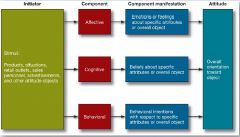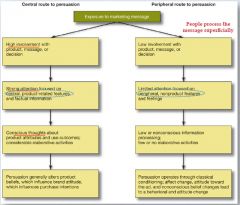![]()
![]()
![]()
Use LEFT and RIGHT arrow keys to navigate between flashcards;
Use UP and DOWN arrow keys to flip the card;
H to show hint;
A reads text to speech;
22 Cards in this Set
- Front
- Back
|
Attitude |
-It is a state of mind that is |
|
|
An attitude is an |
enduring organization of motivational, |
|
|
Attitudes have 3 Components: |
Affective (feelings) Behavior (response tendencies) Cognitive (beliefs) |
|
|
Attitude components and manifestations (process) |

|
|
|
Affective Component of a watch ---> Consumer Attitude = This is a good watch and I like it. |
✽ This watch is so cool. |
|
|
Behavior Component of a watch ---> Consumer Attitude = This is a good watch and I like it. |
✽ I am likely (unlikely) to buy |
|
|
Cognitive Component of a watch ---> Consumer Attitude = This is a good watch and I like it. |
✽ Automatically shows local time |
|
|
What do we use to measure AFFECTIVE attitude components? |
SAM (Self Assessment Manikin) provides visual representation of 232 "emotional adjectives" underlying PAD (pleasure arousal dominance). SAM is a graphical character that is manipulated to portray emotions & more directly tap emotional responses. (dolls w/ 3 rows corresponding to P A D) |
|
|
What do we use to measure COGNITIVE attitude components? |
MULTI ATTRIBUTE MODELS: Attitude is a function of the perceptions Ao = Attitude towards the object
|
|
|
What do we use to measure BEHAVIORAL attitude components? |
Measuring Actions or Intended Actions: Direct questioning. Strongly Disagree1 2 3 4 5 Strongly Agree |
|
|
Which component of attitude represents one's |
behavioral |
|
|
Attitude change strategies: How to change the cognitive component |
-Change beliefs (e.g., Kia is a smooth ride instead of rough) |
|
|
Attitude change strategies: How to change the AFFECTIVE component |
-Classical conditioning -Mere exposure: simply presenting a brand to an individual on a large number of occasions might make the individual's attitude toward the brand more positive. |
|
|
How to change the BEHAVIORAL component |
Behavior can lead directly to affect, to cognitions, or both simultaneously. Changing behavior prior to changing affect or cognition is based on operant conditioning - induce customer to purchase while ensuring that the purchase will indeed be rewarding. |
|
|
Factors influencing attitude change |
✽ Individual characteristics |
|
|
Attitude Change: Elaboration Likelihood Model |
is a theory about how attitudes are formed and changed under varying conditions of involvement. Thus, the ELM integrates select individual, situational, and marketing factors to understand attitudes. -ELM suggest INVOLVEMENT is a key determinant of how info is processed & attitudes changed. |
|
|
ELM: Central vs. peripheral route to persuasion map |

Peripheral: People process the message superficially |
|
|
attitudes |
-Stronger |
|
|
attitudes |
-people process info superficially -lower involvement w/ product |
|
|
Attitude Change: Communication characteristics: 2 |
Source Characteristics - "who" delivers the message Appeal Characteristics- "how" the message is delivered |
|
|
Source characteristics |
|
|
|
Appeal characteristics |
Humourous appeals Comparative ads Emotional Appeals |

